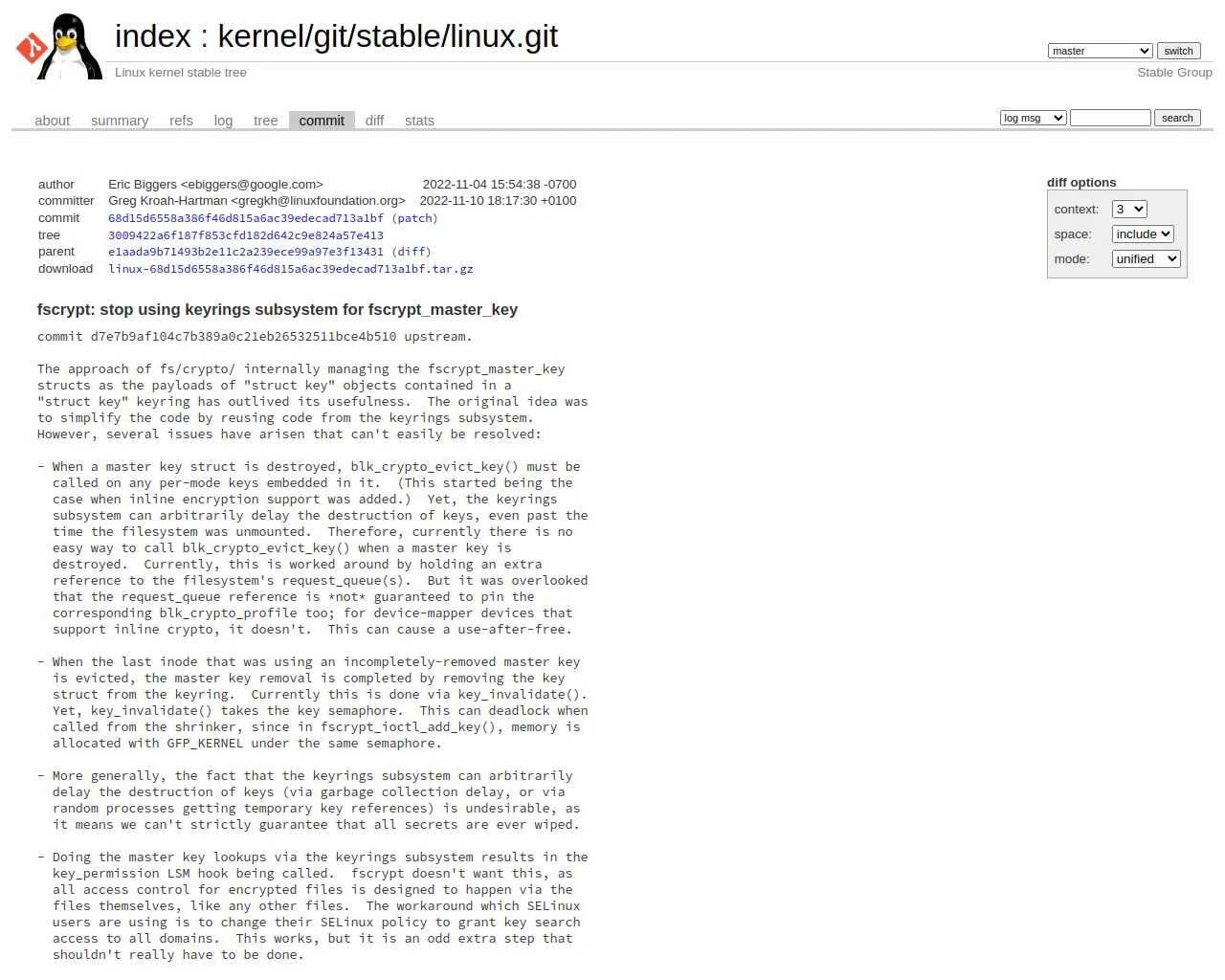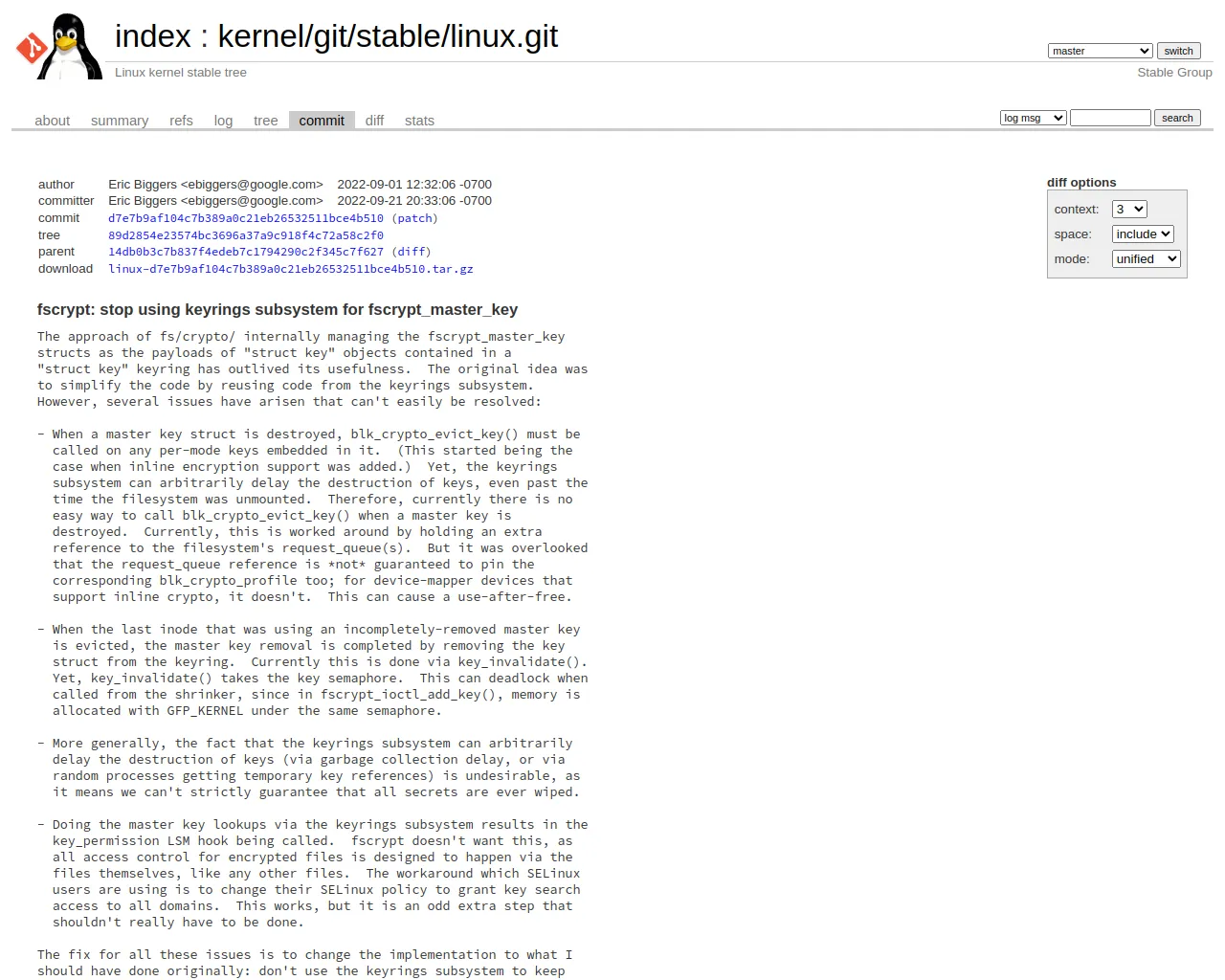漏洞信息
# fscrypt:停止在 fscrypt_master_key 中使用 keyrings 子系统
N/A
提示
尽管我们采用了先进的大模型技术,但其输出仍可能包含不准确或过时的信息。
神龙会尽力确保数据准确,但也请结合实际情况进行甄别与判断。
神龙祝您一切顺利!
漏洞标题
fscrypt: stop using keyrings subsystem for fscrypt_master_key
漏洞描述信息
In the Linux kernel, the following vulnerability has been resolved:
fscrypt: stop using keyrings subsystem for fscrypt_master_key
The approach of fs/crypto/ internally managing the fscrypt_master_key
structs as the payloads of "struct key" objects contained in a
"struct key" keyring has outlived its usefulness. The original idea was
to simplify the code by reusing code from the keyrings subsystem.
However, several issues have arisen that can't easily be resolved:
- When a master key struct is destroyed, blk_crypto_evict_key() must be
called on any per-mode keys embedded in it. (This started being the
case when inline encryption support was added.) Yet, the keyrings
subsystem can arbitrarily delay the destruction of keys, even past the
time the filesystem was unmounted. Therefore, currently there is no
easy way to call blk_crypto_evict_key() when a master key is
destroyed. Currently, this is worked around by holding an extra
reference to the filesystem's request_queue(s). But it was overlooked
that the request_queue reference is *not* guaranteed to pin the
corresponding blk_crypto_profile too; for device-mapper devices that
support inline crypto, it doesn't. This can cause a use-after-free.
- When the last inode that was using an incompletely-removed master key
is evicted, the master key removal is completed by removing the key
struct from the keyring. Currently this is done via key_invalidate().
Yet, key_invalidate() takes the key semaphore. This can deadlock when
called from the shrinker, since in fscrypt_ioctl_add_key(), memory is
allocated with GFP_KERNEL under the same semaphore.
- More generally, the fact that the keyrings subsystem can arbitrarily
delay the destruction of keys (via garbage collection delay, or via
random processes getting temporary key references) is undesirable, as
it means we can't strictly guarantee that all secrets are ever wiped.
- Doing the master key lookups via the keyrings subsystem results in the
key_permission LSM hook being called. fscrypt doesn't want this, as
all access control for encrypted files is designed to happen via the
files themselves, like any other files. The workaround which SELinux
users are using is to change their SELinux policy to grant key search
access to all domains. This works, but it is an odd extra step that
shouldn't really have to be done.
The fix for all these issues is to change the implementation to what I
should have done originally: don't use the keyrings subsystem to keep
track of the filesystem's fscrypt_master_key structs. Instead, just
store them in a regular kernel data structure, and rework the reference
counting, locking, and lifetime accordingly. Retain support for
RCU-mode key lookups by using a hash table. Replace fscrypt_sb_free()
with fscrypt_sb_delete(), which releases the keys synchronously and runs
a bit earlier during unmount, so that block devices are still available.
A side effect of this patch is that neither the master keys themselves
nor the filesystem keyrings will be listed in /proc/keys anymore.
("Master key users" and the master key users keyrings will still be
listed.) However, this was mostly an implementation detail, and it was
intended just for debugging purposes. I don't know of anyone using it.
This patch does *not* change how "master key users" (->mk_users) works;
that still uses the keyrings subsystem. That is still needed for key
quotas, and changing that isn't necessary to solve the issues listed
above. If we decide to change that too, it would be a separate patch.
I've marked this as fixing the original commit that added the fscrypt
keyring, but as noted above the most important issue that this patch
fixes wasn't introduced until the addition of inline encryption support.
CVSS信息
N/A
漏洞类别
N/A
漏洞标题
Linux kernel 安全漏洞
漏洞描述信息
Linux kernel是美国Linux基金会的开源操作系统Linux所使用的内核。 Linux kernel存在安全漏洞,该漏洞源于密钥环子系统使用不当,可能导致主密钥管理问题。
CVSS信息
N/A
漏洞类别
其他



